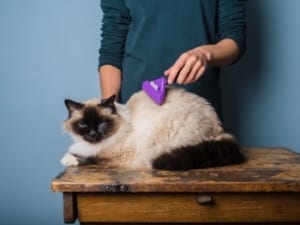 As veterinarians we see a lot of cats throughout the year for routine wellness visits. A common discussion point during these visits is hairballs: What are they? Where does the hair go if there are no hair balls? When should I be worried?
As veterinarians we see a lot of cats throughout the year for routine wellness visits. A common discussion point during these visits is hairballs: What are they? Where does the hair go if there are no hair balls? When should I be worried?
Of course these questions come up because pet parents want to be the best advocates they can be for their furbabies. Many veterinarians and pet owners alike feel hairball vomiting is a normal mechanism to clear hair from your pet’s stomach.
Increased hairball vomiting, however, may be a sign of excessive fur ingestion or an underlying gastrointestinal disease.
Hairball Frequency
Cats ingest hair as part of their normal behavior. The vast majority of the hair should pass through into the feces uneventfully. How can you know if your cat is ingesting a normal amount?
A recent study polling cat owners found:
- As many as 75 percent of cats never have been known to vomit a hairball.
- The remainder of cats will vomit one to two hairballs per year, with long-haired cats slightly more likely to do so than short-haired cats.
Vomiting hairballs more often than this may indicate an underlying concern requiring a visit to your veterinarian. Rarely, hairballs can become partially mineralized within the gastrointestinal tract when they’re retained too long and fail to pass. This contributes to increased vomiting and digestive irritation. It can even cause partial or complete blockage, leading to a medical and/or surgical emergency.
Hairball Management
There is no one-size-fits-all approach to managing hairballs in your furbaby. A variety of options are available, including the following:
Dietary
Dietary approaches to hairball management include changing the diet to investigate whether a food intolerance or allergy could be causing increased vomiting. By trying different diets for your furry friend and monitoring the results, you can reduce the frequency of vomiting, which also eliminates hairballs.
Hairball control diets usually include added fibers to help propel hair along or opting for a larger kibble size, which is thought to “push” hair through out of the stomach. Both approaches allow hair to pass through into the colon and then exit in the feces.
“Natural diets” or “species appropriate” diets – typically raw or homemade diets – also claim to reduce hairball incidence, although controlled studies are lacking.
Another dietary approach includes increasing the number of meals you give your pet per day. This helps increase stomach contractions and helps empty the stomach to keep the digestive process moving along.
Grooming
Grooming approaches for hairball prevention include:
- Reduce the amount of hair ingested by grooming daily
- Clip the haircoat short, also known as “lion clipping”
With both, you’re simply removing the amount of hair your cat has access to ingest; less hair means fewer hairballs.
Medications and Over-the-Counter Supplements
Medications may increase gastric emptying and passage of hair throughout the digestive tract. Talk to your veterinarian before ordering any medication. He or she can discuss your pet’s current medications and other health history with you and determine the best medication option.
Over-the-counter supplements can also help with hairball prevention. For example, adding a lubricant to your furbaby’s routine allows hair to pass and prevents it from sticking together while your cat is digesting it. Lubricants usually come in flavors your cat will enjoy, such as tuna, and it’s easy to administer: All you have to do is put a small amount on your furbaby’s nose or in the mouth.
While an occasional hairball is not a concern with a normal, healthy cat that is eating well and acting normally, more frequent hairball vomiting should be investigated.
Please contact us if you have any concerns about your cat’s vomiting or hairballs.

